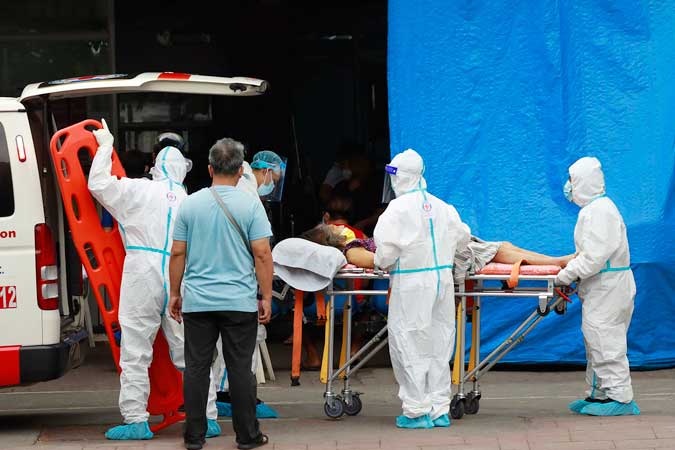PHILIPPINE STAR/ MICHAEL VARCAS
By Vann Marlo M. Villegas, Reporter
THE DEPARTMENT of Health (DoH) reported 5,462 coronavirus infections on Wednesday, bringing the total to 1.29 million.
The death toll rose by 126 to 22,190, while recoveries increased by 7,854 to 1.2 million, it said in a bulletin.
There were 54,000 active cases, 1.4% of which were critical, 92.6% were mild, 3% did not show symptoms, 1.8% were severe and 1.22% were moderate.
The agency said 18 duplicates had been removed from the tally, 14 of which were tagged as recoveries. Seventy recoveries were reclassified as deaths. Eight laboratories failed to submit data on June 7.
About 13 million Filipinos have been tested for the coronavirus as of June 7, according to DoH’s tracker website.
The coronavirus has sickened about 174.8 million and killed 3.8 million people worldwide, according to the Worldometers website, citing various sources including data from the World Health Organization.
About 158.2 million people have recovered, it said.
Meanwhile, Health Undersecretary Maria Rosario S. Vergeire said Davao City, President Rodrigo R. Duterte’s hometown, is not an epicenter of the coronavirus, adding that they discourage tagging areas with rising infections as epicenters.
She said an epicenter is usually understood to be an infection hotspot or the place where it started.
“We discourage the use of the term epicenter in describing the rise of cases in an area,” she said in a statement sent to reporters via Viber. “These areas are not the origin of the COVID-19 (coronavirus disease 2019) virus. Moreover, using the term epicenter detracts from other surrounding areas which may be equally or more affected by COVID-19.”
Ms. Vergeire said they continue to monitor the situation in Davao City where cases have been increasing.
The OCTA Research Group from the University of the Philippines on Tuesday said Davao City had surpassed Quezon City in terms of daily infections.
The city reported an average of 213 new infections from June 1 to 7, 44% higher than a week earlier. Quezon City had an average of 207 cases from June 1 to 7, down from 283.
Also on Wednesday, presidential spokesman Herminio L. Roque, Jr. said the so-called “population protection” could still be achieved in Metro Manila and eight other priority areas.
“We can achieve population protection as we intended specifically for Metro Manila Plus 8 because the numbers are achievable,” he told the ABS-CBN News Channel.
The Philippines seeks to vaccinate at least 500,000 people daily in Metro Manila, Rizal, Bulacan, Cavite, Laguna, Metro Cebu and Metro Davao to achieve herd immunity by Nov. 27.
“I wouldn’t worry about the temporary delay, should be a day or two. Then we can proceed with the vaccination again,” Mr. Roque said.
The spokesman said the one million doses of CoronaVac that recently arrived from China had been distributed to local government units. But they could not be used yet pending quality analysis.
Manila Mayor Francisco M. Domagoso on Tuesday said herd immunity or the vaccination of about 70% of the population was unlikely.
Philippine drug regulators earlier approved the emergency use of Pfizer, Inc.’s coronavirus vaccine for children at least 12 years old, as the government’s vaccination drive breached six million people.
The use of the Pfizer shot was expanded under a May 28 memo issued by the Health department and local Food and Drug Administration (FDA) but released only on Tuesday. The Pfizer drug used to be prescribed for people aged 16 years and older.
FDA Secretary General Enrique D. Domingo earlier said the American drug maker had proposed to change its authorization to include younger people after the vaccine was found to be 100% effective for the age group.
The Philippines is set to receive as many as 40 million doses of the Pfizer vaccine this year. Vaccine czar Carlito G. Galvez, Jr. has said children could get vaccinated by the fourth quarter.
Ms. Vergeire earlier said the government would prioritize the vulnerable population for vaccination and would revisit child vaccination “once our vaccine supply has stabilized.”
Of the six million coronavirus vaccine doses given out as of Monday, almost 4.5 million doses were initial doses, while about 1.6 million doses were second shots, Mr. Roque said.
The government has allotted the bulk of available vaccines in the country to Metro Manila and eight other provinces experiencing high infections. Temperature-sensitive vaccines such as those from Pfizer and Russia’s Gamaleya Institute of Epidemiology and Microbiology were also given out in industrialized areas that can store these in sub-zero temperatures.

